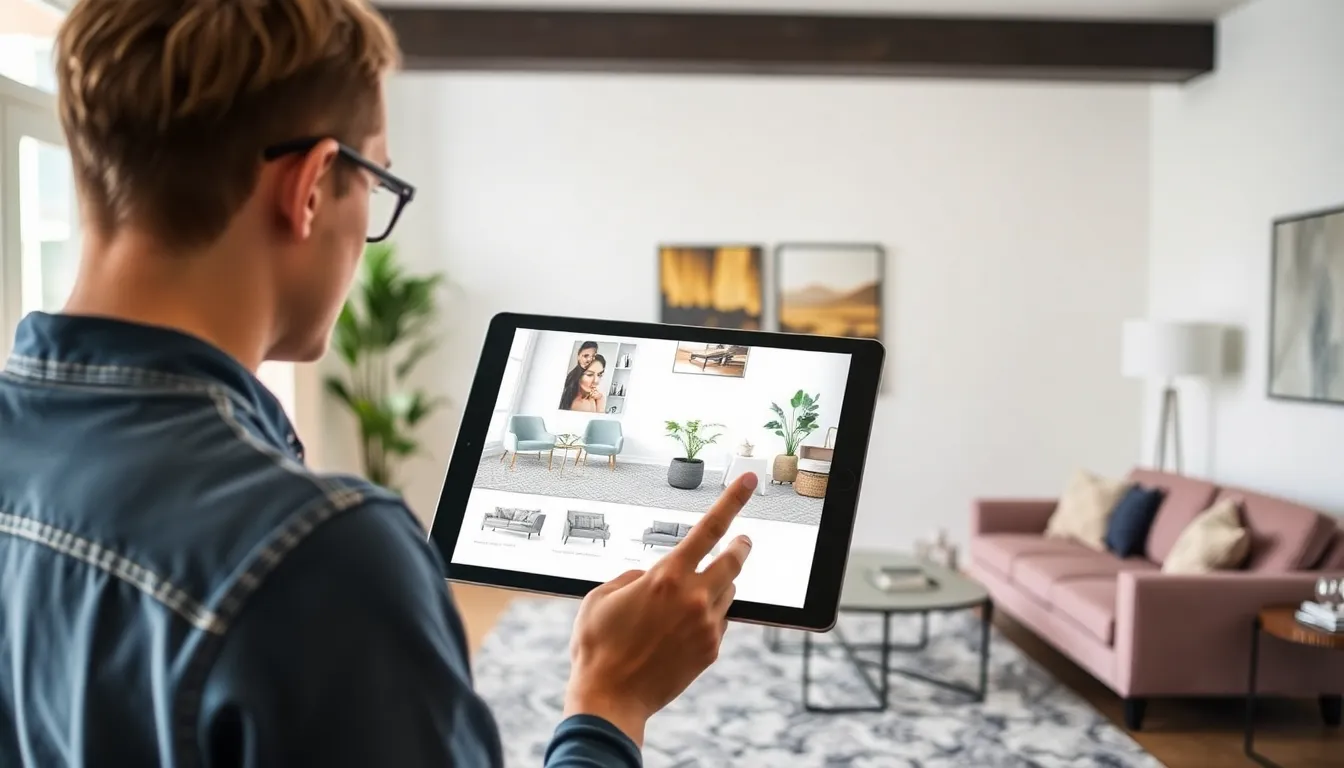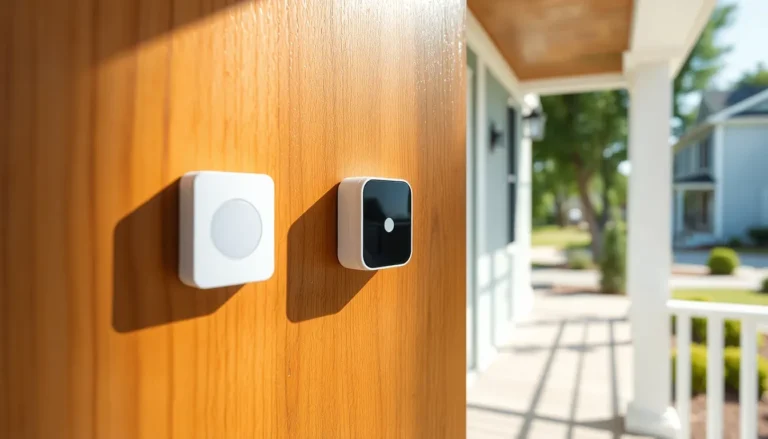Table of Contents
ToggleImagine stepping into a room and instantly knowing where that stylish new couch will fit like a glove. With furniture placement AR, that dream’s a reality. This innovative technology lets users visualize furniture arrangements in real-time, turning the often daunting task of interior design into a fun and interactive experience. No more guessing games or awkward returns—just pure design bliss.
It’s like having a personal interior designer in your pocket, minus the hefty price tag and the awkward small talk. Whether you’re a design novice or a seasoned pro, furniture placement AR takes the stress out of decorating. So, why settle for a haphazardly arranged living room when you can create a space that’s both functional and fabulous? Dive into the world of augmented reality and watch your home transform before your eyes.
Overview of Furniture Placement AR
Furniture placement augmented reality (AR) transforms the way individuals approach interior design. Users visualize furniture items in their spaces before making any purchases. This technology utilizes smartphone cameras and AR software to create an interactive experience.
Real-time visualization helps eliminate errors in furniture selection. Users can adjust sizes and orientations, ensuring everything fits perfectly within the room. This capability provides users with increased confidence in their decorating decisions.
Cost-effective solutions arise from furniture placement AR. Users avoid misjudgments and potential returns associated with unsuitable purchases. AR enhances the overall shopping experience by streamlining the decision-making process.
Compatibility with various devices makes AR accessible. Smartphones and tablets seamlessly integrate this technology to serve a wide range of users. Homeowners, renters, and interior design enthusiasts can all benefit from furniture placement AR.
In addition, this technology fosters creativity and experimentation. Users can explore different styles and layouts without the limitations of physical rearrangements. Personalization becomes straightforward as individuals discover combinations that suit their tastes and lifestyles.
Companies offering AR solutions continue to expand their services. Popular brands incorporate AR into their apps and websites, making planning and shopping enjoyable. As more retailers adopt this technology, users gain access to an extensive range of furniture options and design ideas.
Overall, furniture placement AR represents a significant evolution in interior design, empowering users to create well-designed spaces effortlessly.
Benefits of Using Furniture Placement AR

Furniture placement augmented reality (AR) offers significant advantages for designing and arranging living spaces. Users can experience enhanced creativity and greater precision when utilizing this technology.
Enhanced Visualization
Visualization transforms the way people approach interior design. Users can see how furniture interacts with their space in real-time. Immediate feedback allows for easy adjustments in size and orientation. When furniture is virtualized within the actual environment, it eliminates guesswork. Users can experiment with various styles and arrangements effortlessly. Accurate dimensions facilitate clutter-free designs, helping users develop a keen sense of balance, proportion, and flow. Enhanced visualization leads to a deeper appreciation of how different pieces complement or contrast with each other.
Improved Decision Making
Improved decision making shapes a more confident purchasing experience. Users can visualize potential pieces within their homes, reducing hesitations. This immediate access to realistic representations minimizes the likelihood of errors and costly returns. Choices become more informed, as users better understand how each item fits into their overall vision. Adaptability becomes easier; users can swap options quickly and compare alternatives side by side. Enhanced clarity leads to greater satisfaction with final decisions, streamlining the procurement process.
Popular Furniture Placement AR Tools
Several innovative tools facilitate furniture placement using augmented reality (AR). These applications enhance user experience and foster creativity in interior design.
Tool 1: Features and Benefits
IKEA Place offers an intuitive platform for furniture placement.AR technology enables users to visualize how IKEA products fit into their spaces. This app features a user-friendly interface, allowing individuals to scan rooms effortlessly. Users can adjust furniture sizes and orientations in real-time, ensuring a perfect fit. IKEA Place also showcases an extensive catalog of products, providing ample design options. Benefit from reduced guesswork while improving overall confidence in purchasing decisions.
Tool 2: Features and Benefits
Houzz is another powerful tool that utilizes AR for furniture placement. This platform includes a vast library of furniture and decor items, making room design enjoyable. The app utilizes advanced AR technology to place 3D models of items in any space. Users can visualize how different styles complement each other, enhancing creativity in design. Additionally, Houzz allows users to interact with community members, gathering inspiration from real-life projects. Such collaboration fosters improved decision-making and promotes successful interior design outcomes.
Challenges in Furniture Placement AR
Furniture placement AR faces several challenges that can affect user satisfaction and effectiveness.
Technical Limitations
Technical limitations present hurdles in the deployment of furniture placement AR. AR applications often rely on high-quality sensors and cameras for accurate modeling, leading to inconsistencies in performance across different devices. Inadequate device capabilities may result in poor 3D rendering, affecting how furniture appears in real-time. Additionally, AR experiences can be bandwidth-intensive, causing lag and reducing responsiveness in areas with slow internet. Users may encounter issues with lighting conditions that affect AR accuracy, leading to misrepresentation of furniture sizes and colors.
User Experience Concerns
User experience concerns can hinder the widespread adoption of furniture placement AR. Complexity in some applications may overwhelm first-time users, creating frustration instead of engagement. Users might also experience a steep learning curve when navigating certain AR features, which can discourage experimentation. Compatibility issues across various devices can lead to inconsistent experiences, negatively impacting satisfaction. Furthermore, limited furniture options in certain AR platforms may restrict users’ creative visions, diminishing the appeal of exploring new styles and layouts.
Future Trends in Furniture Placement AR
Advancements in furniture placement AR technology promise exciting transformations in the interior design landscape. Increased integration of artificial intelligence enhances user experiences by offering personalized recommendations based on preferences and room dimensions.
Widespread use of smart home devices ensures seamless connectivity, allowing users to control AR applications through voice commands. Developers focus on improving accuracy in spatial recognition, leading to more precise visualizations of furniture in real-world settings.
Collaborative features emerge, enabling multiple users to interact with the same AR space simultaneously. Such functionality supports group decision-making, making family design projects more inclusive and enjoyable.
Mobile platforms witness rapid advancements, ensuring that AR applications run on a wider range of devices with improved performance. Enhanced realism in rendering helps users visualize textures and materials as they would appear in their homes.
Sustainability trends influence AR furniture choices, encouraging companies to showcase eco-friendly products. Users benefit from features that highlight the environmental impact of selections, promoting conscious consumption.
Integration of virtual reality elements within AR applications fosters immersive design experiences. This approach allows users to step inside virtual models, facilitating better understanding of space and flow.
Innovative partnerships between furniture retailers and AR developers are likely to expand options available to consumers. Access to an extensive network of furniture and decor items will strengthen user creativity and flexibility in design.
Overall, future trends in furniture placement AR aim to enhance user engagement, support creativity, and make interior design accessible to everyone.
Furniture placement AR is revolutionizing the way people approach interior design. By providing a platform for visualization and experimentation, it empowers users to make informed decisions about their spaces. The technology not only enhances creativity but also streamlines the purchasing process, reducing the likelihood of costly mistakes.
As AR continues to evolve, its integration with artificial intelligence and smart home devices will further enrich user experiences. The future looks promising as advancements in spatial recognition and rendering realism pave the way for more immersive design opportunities. Embracing furniture placement AR is no longer just an option; it’s becoming an essential tool for anyone looking to create stylish and functional living environments.







